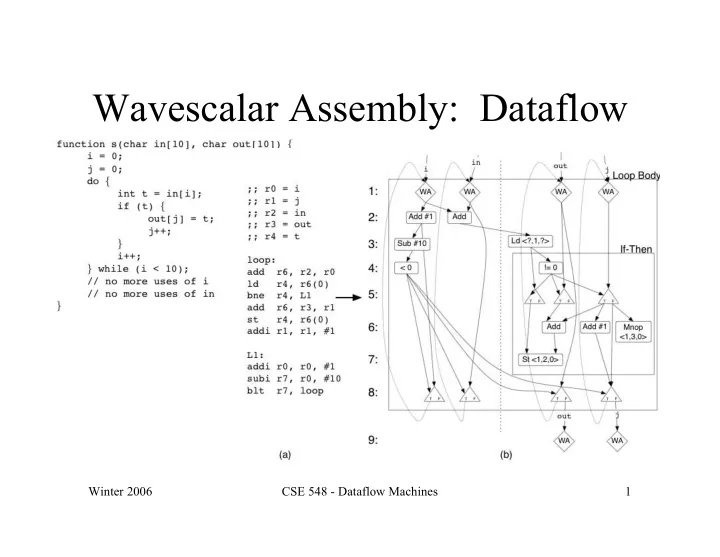

Wavescalar Assembly: Dataflow Winter 2006 CSE 548 - Dataflow Machines 1
Wavescalar Assembly: Format • Wavescalar is an extension of the Alpha ISA – RISC (more or less) – “Register to register” becomes “PE to PE” – Tagged-tokens • Instructions have a basic format operand {outputs}, {inputA}, {inputB}, {inputC} – Each port may hold a list of inputs or outputs – Some instructions have less inputs – The curly braces are optional Winter 2006 CSE 548 - Dataflow Machines 2
Referring to Arcs • Named arcs – You have infinite “registers” ldq a, addr, 0 ldq b, addr, 8 addq c, a, b • Use labels – The linker resolves symbols (if possible) L0: ldq { }, addr, 0 ldq ^L1:2, addr, 8 L1: addq c, ^L0:0, { } Winter 2006 CSE 548 - Dataflow Machines 3
Wavescalar Assembly: Instructions Alpha-based Wavescalar Specific • Computation • Control – Branches/Joins • Tag management • Memory – Wavescalar is – Ordered interface dynamic dataflow – Unordered • Synchronization For a list of all instructions and formats, run: lc-devel/src/drip/printInsts Winter 2006 CSE 548 - Dataflow Machines 4
Alpha-based Instructions http://www.cs.cmu.edu/afs/cs.cmu.edu/academic/class/15740- f98/public/doc/alpha-guide.pdf • Arithmetic – add, sub, mul, div, … – Long word (32 bit) arithmetic addl {outputs}, {inputAs}, {inputBs} – Quad word (64 bit) arithmetic addq {outputs}, {inputAs}, {inputBs} • Comparison – cmple, cmpeq, … • Logical – and, bis, xor, … Winter 2006 CSE 548 - Dataflow Machines 5
Using Immediates • Almost all instructions have immediate forms – AddI, sll_I, s4subq_I, … Addi {outputs}, {inputs}, immediate • Otherwise, create a constant and send it – cnst creates an immediate when a trigger is received cnst {outputs}, {triggers}, immediate Winter 2006 CSE 548 - Dataflow Machines 6
Accessing Memory Unordered Ordered • ldq, stq, mnop, … • ldq_U, stq_U • The system • The programmer manages manages dependences dependences – Store buffer – Dataflow firing rule • Memory operations • Stores have an are tagged output arc – Wave-ordered – Reports when store memory completes Winter 2006 CSE 548 - Dataflow Machines 7
Wave-Ordered Memory • Programs are partitioned into DAGs (“waves”) • Memory operations are given “sequence numbers” – <previous, current, next>.ripple ld {outputs}, {address}, immediate <p, c, n>.r • No-ops may be required to totally order operations Winter 2006 CSE 548 - Dataflow Machines 8
Ripples • A sequence of loads need not be ordered – The hazards are RAW, WAR, WAW • Fully ordering loads decreases parallelism • Add a “ripple number” – The previous store’s sequence number Winter 2006 CSE 548 - Dataflow Machines 9
Tagged Tokens • Wavescalar is a tagged-token architecture – Each token has two components • A value • A tag – Each tag has two components • A thread number • A wave number • Tags allow re-entrant code – The dataflow firing rule is modified An instruction executes when all of its operands for a given thread and wave have arrived. Winter 2006 CSE 548 - Dataflow Machines 10
Re-entering a Wave • Each dynamic wave is assigned a wave number • Tokens entering a wave are tagged with that wave number – Wave advance (wa) • Increments the wave number on a token – Canonical wave advance (cwa) • Increments the wave number • Creates a new memory ordering for that wave • Multiple memory orderings can exist…but talk to us first Winter 2006 CSE 548 - Dataflow Machines 11
Ordered and Unordered Winter 2006 CSE 548 - Dataflow Machines 12
Control: Token Steering • No branch instructions • Two control instructions – rho (split): conditional rho {T-output}, {F-output}, {value}, {predicate} – phi (join): speculative phi {output}, {T-value}, {F-value}, {predicate} value T path F path predicate predicate + + T path F path value Winter 2006 CSE 548 - Dataflow Machines 13
Steering Example Winter 2006 CSE 548 - Dataflow Machines 14
Control: Jumps • Sometimes, destinations must be resolved dynamically – Indirect send, indirect receive – Dynamic resolution is fairly slow • Macros will be provided for function calls and returns Winter 2006 CSE 548 - Dataflow Machines 15
Control: Wave Management • Wave advance is an optimization – Only increments wave numbers • Wave number manipulation is used to pass values around loops or complex control – Wave-to-data (wtd): outputs the wave number wtd {wave-as-output}, {input} – Data-to-wave (dtw): sets a wave number dtw {output}, {new-wave-input}, {value-input} Winter 2006 CSE 548 - Dataflow Machines 16
Control: Thread Management • Values can be passed between threads by altering the tags – Thread-to-data (ttd): outputs the thread id ttd {thread-as-output}, {input} – Data-to-thread (dtt): sets the thread id dtt {output}, {new-thread-input}, {value-input} – dttw: sets the thread id and wave number dttw {output}, {thread}, {wave}, {value} Winter 2006 CSE 548 - Dataflow Machines 17
Concerns about Thread Management • Sending values to a new thread is equivalent to an indirect send – Each thread has its own set of instructions – Destinations are resolved when the thread id is received • Two kinds of threads exist – Light: unordered (or no) memory • Easy to create, requires very little support – Heavy: requires memory ordering support • If you want multiple memory orderings, talk to us first • Thread ids should be unique across the system – Operating system concern Winter 2006 CSE 548 - Dataflow Machines 18
Synchronization • For lightweight threads, lightweight synchronization is needed – Thread Coordinate (tc): implements a m-structure • Requires a different firing rule Winter 2006 CSE 548 - Dataflow Machines 19
Recommend
More recommend